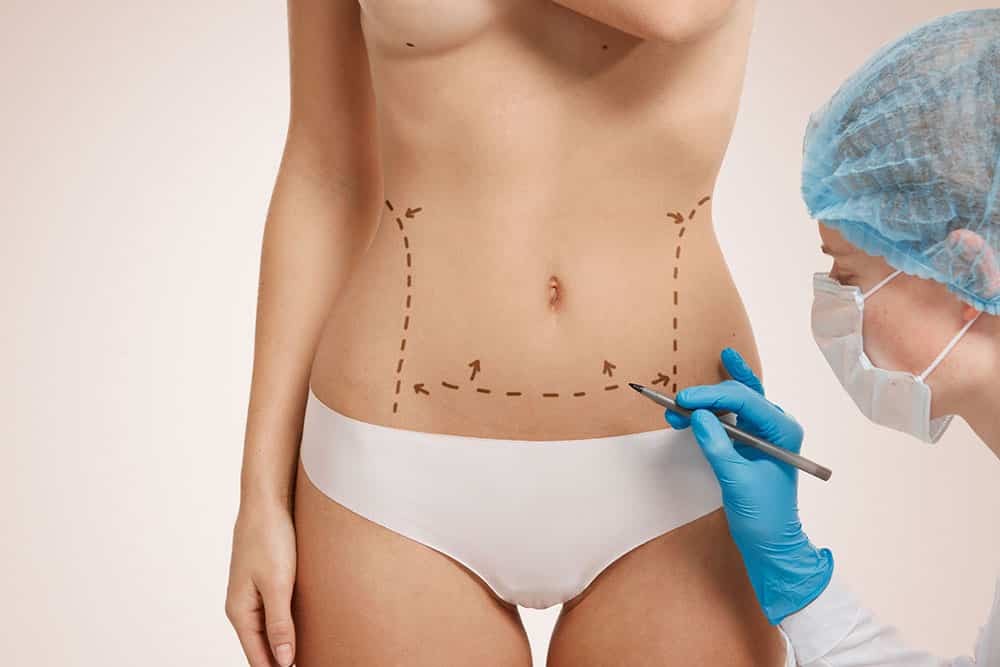What is an belly button surgery(Umbilicoplasty)?
An umbilicoplasty, also known as belly button surgery, is a surgical procedure which aims to change the appearance of your belly button, making it more aesthetically pleasing.
The goal of umbilicoplasty is to give the belly button a more vertical shape, rather than a horizontal one, or to turn an outward belly button into an ‘innie’. Belly button surgery is particularly popular with women who have seen the size and shape of their belly button change as a result of pregnancy. Umbilicoplasty is also commonly carried out on people who have scarring left behind after a belly button piercing.
Belly button surgery is quick and straightforward and is performed as a day case, meaning that you will be able to go home on the same day as your surgery. The procedure takes around one to four hours from start to finish. It also has a quick recovery time and you should be fully healed by two to four weeks.
Umbilicoplasty is commonly performed alongside liposuction and/or abdominoplasty, if you also wish to have excess fat or skin removed from your abdomen.
Why Iran?
You don’t need to be a plastic surgery guru to know that Iran is considered a major hub for all medical and cosmetic procedures. Thanks to the significant popularity of cosmetic procedures in Iran, the country boasts some of the most experienced plastic surgeons in the world. Additionally, Iranians health centers are the best in the region and on par with those in Europe or the USA. But the major reason as to why Iran is a medical tourism hub in the middle east is the affordability of procedures despite the topnotch quality of care.
People seek umbilicoplasty if they are unhappy or dissatisfied with the shape or size of their belly button. Your belly button can change appearance due to pregnancy or following a large weight loss and you may not be happy with how it looks. Belly buttons are often visible when wearing swimwear and underwear, so a person who is unhappy with the appearance of their belly button may find they feel anxious about exposing this particular part of their body. In some cases this means avoiding certain activities and situations, such as swimming, sunbathing and communal changing rooms, all together. This lack of self-confidence and self-esteem can also have an impact on romantic and intimate relationships.
Umbilicoplasty can also fix a prominent ‘outie’ belly button caused by an umbilical hernia, as well as scarring left behind from a belly button piercing.
Some people feel self conscious about the appearance of their belly button, and an umbilicoplasty is a procedure with many varied benefits. Patients may choose to get the surgery for any of the following reasons:
- ‘Innie’ to ‘outie’ – Turn what is commonly called an ‘outie’ (where the skin in the belly button protrudes outward) into an ‘innie’ (where the belly button dips inward).
- Deal with scars – Remove scars in the belly button from a piercing or prior surgery.
- Fix umbilical hernias – Repair an umbilical hernia which presents as a painless bulge in or around the belly button.
- Adjust size – Reduce the size of naturally large navels or an expanded belly button due to pregnancy or significant weight loss.
- Repair injury – You may have suffered a traumatic injury that has changed the shape or appearance of your belly button. umbilicoplasty surgery can help to repair this damage.
- Correct Previous Abdominal Surgeries: For some individuals, a procedure they had in the past may have left them with a belly button that needs to be corrected with further surgery.
What are the risks of belly button reconstruction?
As with any procedure, a belly button reconstruction procedure carries some risks.
Anesthesia may cause complications such as breathing problems during and after the surgery.
Complications from the surgery may include Trusted Source:
- infection
- umbilical stenosis, which is narrowing of the umbilical opening
- umbilical necrosis, which is the death of umbilical tissue
- scar hypertrophy
- transient skin erythema, or changes to skin color
A person should discuss possible risks with the surgeon they choose to do the procedure.
Is belly button surgery painful?
During the belly button surgery procedure you will receive an aesthetic and, therefore, no pain or discomfort should be felt. After the procedure you may experience some discomfort in the surrounding area. However, this should not last for more than 1-2 weeks.
AM I A CANDIDATE FOR BELLY BUTTON RESHAPING?
Good candidates are generally unhappy with their belly button appearance and have realistic expectations for the procedure. Dr. Goldschmidt will ask you to quit smoking and adjust your medications prior to your surgery. Discuss your medical history, concerns, and preferences during your consultation with Dr. Matt Goldschmidt in Cleveland, Ohio to fully communicate everything you desire from your surgery.
HOW IS BELLY BUTTON SHAPING PERFORMED?
Belly button reshaping or Umbilicoplasty is commonly performed in conjunction with tummy tuck surgery or liposuction, but Dr. Goldschmidt can also complete it as a standalone procedure if your belly button is your only area of concern.
Dr. can conduct the procedure with light sedation (twilight anesthesia), general anesthesia, or local anesthesia. Excess skin is trimmed away, the umbilicus is reshaped, sometimes repositioned, and Dr. uses sutures to close the incision and secure your restructured belly button. The entire procedure usually takes less than an hour to perform.
WHAT IS RECOVERY AFTER BELLY BUTTON SHAPING LIKE?
Most patients return home the same day as their procedure. Mild discomfort, swelling, and bruising is normal and patients can relieve the symptoms with prescription pain medication. Returning to work can take a day or two, and you should avoid exercise for the first two or three weeks.
Your plastic surgeon will provide recovery care instructions to help you keep your belly button clean and dry. Dr. usually removes stitches within 10 days unless they are dissolvable. Symptoms should dissipate within two weeks with little scarring.

























